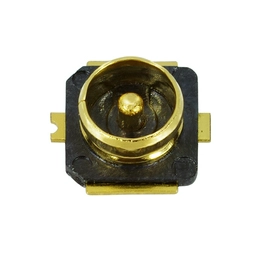Coaxial Connectors
Coaxial Connectors (RF) are specialized types of connectors designed for radio frequency (RF) applications, where maintaining signal integrity and minimizing signal loss is crucial. They are used to join two coaxial cables or connect a coaxial cable to an RF device, such as antennas, transmitters, and receivers.
Definition:
Coaxial connectors, also known as RF connectors, are electrical connectors that are designed to work with coaxial cables. They consist of a center conductor surrounded by an insulating dielectric, which is then enclosed by a conductive shield or braid. The shield is typically connected to ground to provide shielding from external electromagnetic interference.
Function:
1. Signal Transmission: They facilitate the transmission of high-frequency signals with minimal loss and distortion.
2. Impedance Matching: Coaxial connectors are designed to match the impedance of the connected cables and devices, ensuring efficient signal transfer.
3. Shielding: The outer shield provides protection against electromagnetic interference, which is essential for maintaining signal quality in RF applications.
Applications:
1. Telecommunications: Used in cellular networks, communications, and cable TV systems.
2. Broadcasting: Employed in radio and television broadcasting equipment.
3. and Defense: Critical in radar systems, dishes, and communication systems.
4. Medical Equipment: Used in medical imaging and diagnostic equipment that requires high-frequency signal transmission.
5. Automotive: Found in GPS systems, infotainment systems, and other vehicle communication systems.
Selection Criteria:
1. Frequency Range: Choose a connector that supports the frequency range of your application.
2. Impedance: Ensure the connector has the correct impedance (typically 50 or 75 ohms) to match your system.
3. Insertion Loss: Look for low insertion loss to minimize signal degradation.
4. VSWR (Voltage Standing Wave Ratio): Select connectors with a low VSWR for better signal transmission.
5. Physical Size and Shape: Consider the physical dimensions and form factor to ensure compatibility with your equipment.
6. Durability and Environmental Resistance: For outdoor or harsh environments, choose connectors with appropriate sealing and material specifications.
7. Cost: Consider the cost-effectiveness of the connector, especially for high-volume applications.
In summary, coaxial connectors are essential components in RF systems, providing a reliable and efficient means of connecting and transmitting high-frequency signals. Their selection should be based on the specific requirements of the application, including frequency range, impedance, and environmental conditions.
Please refer to the product rule book for details.
Definition:
Coaxial connectors, also known as RF connectors, are electrical connectors that are designed to work with coaxial cables. They consist of a center conductor surrounded by an insulating dielectric, which is then enclosed by a conductive shield or braid. The shield is typically connected to ground to provide shielding from external electromagnetic interference.
Function:
1. Signal Transmission: They facilitate the transmission of high-frequency signals with minimal loss and distortion.
2. Impedance Matching: Coaxial connectors are designed to match the impedance of the connected cables and devices, ensuring efficient signal transfer.
3. Shielding: The outer shield provides protection against electromagnetic interference, which is essential for maintaining signal quality in RF applications.
Applications:
1. Telecommunications: Used in cellular networks, communications, and cable TV systems.
2. Broadcasting: Employed in radio and television broadcasting equipment.
3. and Defense: Critical in radar systems, dishes, and communication systems.
4. Medical Equipment: Used in medical imaging and diagnostic equipment that requires high-frequency signal transmission.
5. Automotive: Found in GPS systems, infotainment systems, and other vehicle communication systems.
Selection Criteria:
1. Frequency Range: Choose a connector that supports the frequency range of your application.
2. Impedance: Ensure the connector has the correct impedance (typically 50 or 75 ohms) to match your system.
3. Insertion Loss: Look for low insertion loss to minimize signal degradation.
4. VSWR (Voltage Standing Wave Ratio): Select connectors with a low VSWR for better signal transmission.
5. Physical Size and Shape: Consider the physical dimensions and form factor to ensure compatibility with your equipment.
6. Durability and Environmental Resistance: For outdoor or harsh environments, choose connectors with appropriate sealing and material specifications.
7. Cost: Consider the cost-effectiveness of the connector, especially for high-volume applications.
In summary, coaxial connectors are essential components in RF systems, providing a reliable and efficient means of connecting and transmitting high-frequency signals. Their selection should be based on the specific requirements of the application, including frequency range, impedance, and environmental conditions.
Please refer to the product rule book for details.
Categories
Datasheets
SMP-MSLD-PCS17T Datasheet
U.FL-R-SMT-1(80) Datasheet
20441-001E-01 Datasheet
RF2-44A-T-00-50-G Datasheet
5020 Datasheet
51Z120-000B Datasheet
TC-400-BM-X Datasheet
99S20D-40MA5-A Datasheet
PSMP-MSSB-PCT1R Datasheet
59S22B-40MT5-C Datasheet
U.FL-R-SMT(10) Datasheet
R125462000 Datasheet
SMB1252B1-3GT30G-50 Datasheet
FM4-NARP-PCB-1 Datasheet
37_BNC-50-0-1/133_NE Datasheet
Article

Digital Signal Processors (DSPs) Explained: Transforming Data into Real-Time Solutions
Introduction: What is a Digital Signal Processor (DSP)? In the world of modern electronics, the need to process and manipulate digital signals quickly and efficiently is crucial. Whether it's audio, video, or sensor data, digital signal processors (DSPs) have emerged as the backbone for performing these complex tasks in real-time. But what exactly is a DSP? Figure 1: Digital Signal Processor A Digital Signal Processor (DSP) is...
Learn More >

The Difference Between Microprocessors and Application Processors
In the rapidly evolving world of technology, understanding the distinctions between microprocessors and application processors is crucial for anyone involved in electronics, software development, or product design. Both types of processors play vital roles in the functioning of electronic devices, yet they serve different purposes and are optimized for various applications. In this article, we’ll explore the key differen...
Learn More >

The Heart of Smart Devices: Exploring the Role of Application Processors and SOC
In today’s rapidly evolving technological landscape, application processors and system-on-chips (SOC) have emerged as the fundamental components powering a wide range of smart devices. These sophisticated chips enable the seamless operation of modern electronics, offering enhanced performance, power efficiency, and integration. This article explores the roles, features, types, and future directions of application process...
Learn More >






















